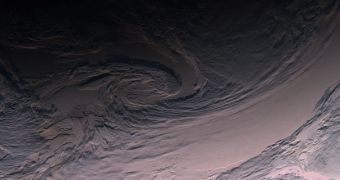The image above is the last sent by the Rosetta spacecraft, a mission developed by the European Space Agency (ESA) to rendezvous with, and study, comet 67P/Churyumov–Gerasimenko. The satellite was launched on March 2, 2004, and carried out three flyby maneuvers around our planet.
The first flyby occurred on March 4, 2005, the second on November 13, 2007, and the third one on November 12, 2009. It was during the last one that the spacecraft was able to capture this beautiful image of a large anticyclone swirling above the southern Pacific Ocean.
ESA experts used orange, green, and blue filters on Rosetta's cameras to capture this false-color composite image of the large storm. At its point of closest approach to Earth, the vehicle flew just 2,481 kilometers (1,541 miles) away from our planet.
Rosetta's mission is to meet up with the comet and then orbit it for 17 months. During this time, it will deploy its Philae lander on the surface of the celestial body. This will be the most complex and exhaustive study of a comet ever undertaken.

 14 DAY TRIAL //
14 DAY TRIAL //